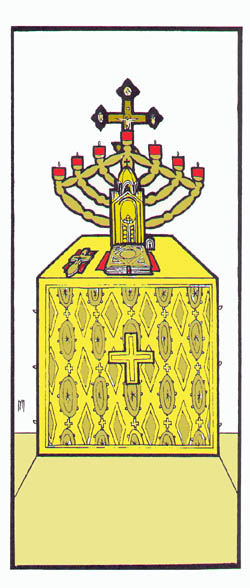Altar Table
We have mentioned how the entire church building is centered around the altar table. The altar table does not merely symbolize the table of the last supper. It is the symbolic and mystical presence of the heavenly throne and table of the Kingdom of God; the table of Christ the Word, the Lamb and the King of the ever-lasting life of God’s glorified dominion over all of creation.

The Book of the Gospels is perpetually enthroned on the altar table. It is on the altar table that we offer the “bloodless sacrifice” of Christ to the Father. And from the altar table we receive the Bread of Life, the Body and Blood of the Lord’s Passover Supper. This table is the “table of God’s Kingdom” (Lk 13.29).
In Orthodox Tradition the altar table is often carved wood or stone. It is usually vested with colorful material to show its divine and heavenly character. It should always be a simple table of proportional dimensions, often a perfect cube, and is always free-standing so that it may be encircled.
On the altar table one always finds the antimension. This is the cloth depicting Christ in the tomb which contains the signature of the bishop and is the permission for the local community to gather as the Church. “Antimension” means literally “instead of the table.” Since the bishop is the proper pastor of the Church, the antimension is used instead of the bishop’s own table which is, obviously, in his own church building, the cathedral—the place where the bishop has his chair (cathedra).
The antimension usually contains a relic (normally a part of the body) of a saint which shows that the Church is built on the blood of the martyrs and the lives of God’s holy people. This custom comes from the early Church practice of gathering and celebrating the eucharist on the graves of those who have lived and died for the Christian faith. Usually, a relic of a saint is embedded in the altar table itself as well.
Also on the altar table there is a tabernacle, often in the shape of a church building, which is a repository for the gifts of holy communion that are reserved for the sick and the dying. Behind the altar table there is usually a seven-branched candle stand which comes from the Old Testamental tradition of the Jewish temple. Generally speaking, the Jerusalem temple is highly valued in the Orthodox Christian tradition of worship and church construction as a “prototype” of the true worship “in spirit and truth” of the Kingdom of God (Jn 4.23).
